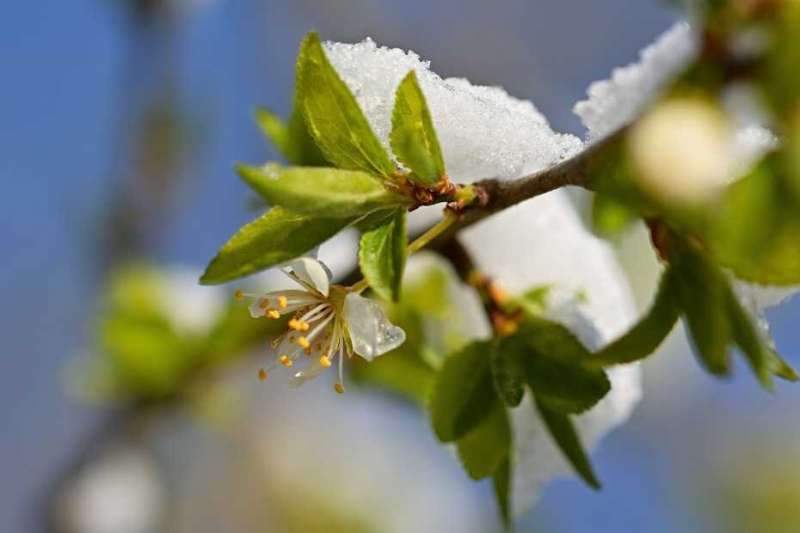Forests in Europe and Asia at greater risk of damaging cold snaps

ETH researchers find climate change is increasing the risk of late-spring frost in areas where plants are not adapted to this kind of temperature swing, putting some forests of Europe and Asia at higher risk of damage.
Climate change is putting temperate trees in Europe and Asia at greater risk to late-spring cold snaps—which threatens ecosystems, agriculture and economies—finds new research led by the Crowther Lab at ETH Zurich, published in the journal PNAS.
Increased warming in early spring is causing leaves to emerge on trees earlier in the year. Recent estimates show this advance in leaf-out could be as much as two weeks on average through the rest of the century. Early leaf-out puts trees at greater risk of severe damage from late-spring frosts, as young leaves are more vulnerable to freezing. The new study shows that the occurrence of such late spring frosts is increasing.
Predicting future risk
The most dramatic risk increase is in areas where late-spring frosts were infrequent: coastal and eastern parts of Europe and East Asia. In those areas, many local trees are "opportunistic," and leaf out after just short periods of warming. This suggests that climate change will lead to a mismatch between late-spring frost incidences and trees' strategies to cope with frosts. Therefore, researchers expect that 35% and 26% of the European and Asian temperate forests will become increasingly vulnerable to spring frosts in the future. Constantin Zohner, lead author of the study, said: "I started to investigate frost risk because I noticed leaves dying around my home in Germany. Some species were resistant, others susceptible. I wanted to show global differences and evolutionary adaptations and found frost risk increased most in Europe and East Asia." Thomas Crowther, of the Crowther Lab at ETH Zurich and senior author of the study said: "By providing a quantitative and spatially-explicit understanding of late-spring-frost risk, this study can be valuable for guiding agriculture, forestry, and environmental decision making."
Frost risk impacts economies and climate change
Global warming is associated with excessively hot weather and summer heatwaves. However, climate change will exacerbate all kinds of extreme weather and cold snaps are not to be disregarded. In March 2017, a cold snap killed half the iconic cherry blossoms in Washington, DC which had emerged early following an unseasonably warm February. That same year, an unprecedented warm period induced vegetation to spring out in western Europe before a late spring frost in April. This frost event caused severe damage to natural and cultivated plants, which altogether led to an estimated 3.3 billion euros of economic loss, of which only 18% were insured, according to MunichRe.
The reduced photosynthesis resulting from leaf damage also contributes to an increase of carbon in the atmosphere. Damaged trees do not absorb as much carbon.
Mapping frost patterns and plant traits
The new big-data study analyzed hourly temperatures around the world over a 60-year period and mapped nearly 1,500 species for their susceptibility to frost. Pairing annual frost occurrences and plant characteristics at the global scale allowed researchers to forecast the vulnerability of forests to late frost events under climate change.
The maps show that these cold snaps are generally more frequent in North America than in Europe and Asia. This is mainly due to the absence of east-west mountain ranges in North America allowing warm spells from the Gulf of Mexico and cold spells from arctic regions to move across the continent unimpeded, resulting in high short-term temperature variability. The study also finds that many trees in areas historically prone to spring frost risk, like North America, have invested in certain protective measures. These "cautious" trees do not leaf out unless they have experienced enough warmth. This caution provides a valuable insurance policy against frost damage which can affect their growth, reproduction and survival.
More information: Constantin M. Zohner et al. Late-spring frost risk between 1959 and 2017 decreased in North America but increased in Europe and Asia, Proceedings of the National Academy of Sciences (2020). DOI: 10.1073/pnas.1920816117
Journal information: Proceedings of the National Academy of Sciences
Provided by ETH Zurich





















